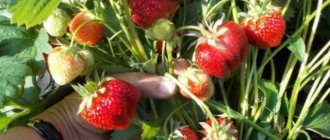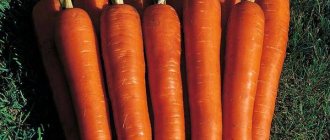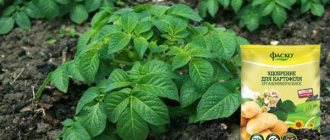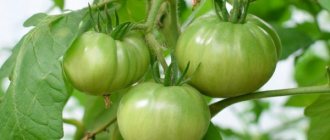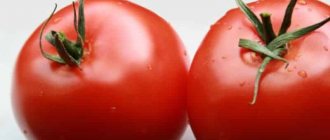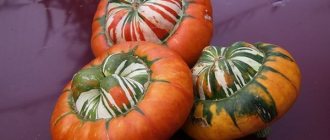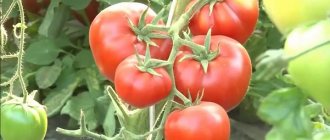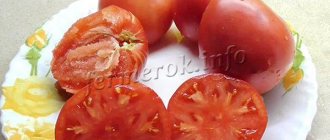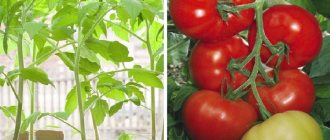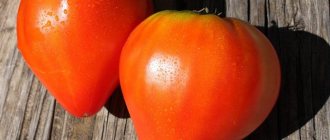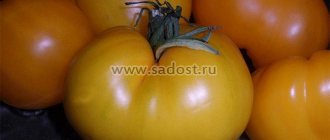Description and characteristics of onions of the Carmen variety
Carmen onions, in accordance with the State Register of the Russian Federation, are recommended for cultivation in the Central, Central Black Earth, Middle and Lower Volga regions. The ripening time of the variety depends on the planting method.
Appearance
Carmen bulbs have a rounded-flat shape. Dry purple scales. There are 2-3 of them in total. The pulp density is average. Its main color is white, between the individual skirts it is carmine red. The height of the green feather reaches 30 cm.
The flesh of the Carmen onion is juicy. The taste is slightly spicy, slightly sweet. The bulbs weigh on average 110 g. The maximum weight is observed when grown through seedlings.
The Carmen variety has been included in the State Register of the Russian Federation since 1997; an application for zoning was submitted in 1994.
Ripening time and yield
The entire growing season of Carmen onions from sowing to full ripening takes 124-129 days. According to this indicator, the variety is considered late.
Onions can be grown as an annual crop from seeds or as a biennial crop from sets. Massive lodging and yellowing of feathers occurs after 120-140 days.
The yield of Carmen onions depends on the region. The commodity indicator in the Central region is 157 kg per hundred square meters. In the Central Black Earth region the numbers are the same. The yield in the Middle Volga region reaches 285 kg per hundred square meters when grown from sets. According to reviews from gardeners, 3-4 kg of onions can be harvested from 1 m².
Resistance to diseases and pests
Onion Carmen has good immunity. The variety is especially resistant to the following diseases and pests:
- rust;
- peronosporosis (downy mildew);
- rot;
- onion fly;
- thrips.
In addition to good immunity to some diseases and pests, Carmen onions are quite resistant to temperature fluctuations and dry periods.
Composition and properties
100 g of Carmen onion contains up to 19.5 mg of ascorbic acid, an average of 8.25 mg of sugar, 12.9 mg of dry matter. These figures are valid for the product in its raw form. It also contains other valuable elements:
- vitamins A, P, group B (thiamine, pyridoxine, riboflavin, pantothenic acid);
- a complex of minerals, including iron, zinc, potassium, iodine, magnesium, cobalt, copper;
- sucrose, fructose;
- phytoncides;
- antioxidants.
Thanks to its rich composition, Carmen onion has beneficial properties:
- weight loss;
- anti-inflammatory and antibacterial effects;
- increasing immunity;
- reduction in blood sugar;
- stimulation of insulin production;
- activation of collagen formation.
Such qualities make Carmen onions useful for colds, diabetes, obesity, and pathologies of the nervous system.
Comment! The norm for consuming raw red onions is 100 g per dose. The product is contraindicated for pancreatitis, gastrointestinal ulcers, and kidney diseases.
Areas of application
The Carmen bow is universal in use. The variety is especially good for salads and cold appetizers. The pulp looks beautiful and retains its taste when pickled. Carmen is also suitable for heat treatment, but after boiling or frying it acquires a grayish tint. The changes concern only the appearance, the taste of the product does not deteriorate.
Red onions are used in folk medicine. It is consumed raw, and infusions, decoctions, juices, and lotions are made from it.
Problems during cultivation
Onions are affected by more than 50 types of diseases and parasites that destroy above-ground and underground parts of the plant. Pre-sowing preparation of the material protects the crop from the most common infections, but improper cultivation provokes the appearance of fungi. It is easier to prevent a problem than to later destroy the crop and disinfect the soil:
- do not bring seed from infected farms;
- Before planting, cultivate the soil and working tools;
- regularly reduce the number of parasitic insects;
- use repellents and insecticidal plants.
To protect the crop from fungal damage, you cannot grow onions in one place for several years in a row. Experienced farmers recommend returning the crop no earlier than after 3-4 years. During this time, all infectious diseases will disappear. Never leave plant debris on the site - this is a good environment for the development of diseases.
Carefully inspect the plantation for the presence of insect pests. At the first signs of parasites, use special preparations that are purchased at hardware stores. Regular processing will protect crops from unwanted guests.
By growing onions of the Carmen selection on your plot, you will get a high yield with a minimal investment of money and effort. With proper cultivation of the vegetable, no diseases or pests will be afraid of you. The bulbs are stored for a long time, maintaining their taste throughout the entire period.
Entry Description of onion variety: Carmen first appeared SeloMoe.
Pros and cons of the variety
Consumers value Carmen onions for their good taste, valuable composition, and beneficial properties. They are fully manifested when the product is consumed raw.
The ripening of Carmen onions before harvesting is 90-100%, after ripening 95-100%
Pros:
- aligned bulb shape;
- stable yield;
- good ripening;
- possibility of growing in different ways;
- resistance to shooting;
- immunity to certain diseases and pests;
- excellent taste;
- versatility of use;
- suitability for long-term storage;
- Suitable for planting before winter.
The Carmen variety has no obvious deficiencies.
Description
Onions of the Carmen variety are a development of Dutch breeders, successfully used in domestic gardening. This variety has already gained quite a popularity among our summer residents due to its mild taste and low maintenance requirements.
The variety is early ripening, which is also liked by many. It matures, depending on the climate zone, from 65 to 90 days. In our country, Carmen onions began to be grown not so long ago, but thanks to their valuable properties and unpretentiousness, the culture is gaining more and more fans in all regions.
In the photo - Onions of the Carmen variety:
Luk Carmen
The variety ripens quickly: 75-85 days after planting, you can already harvest a rich harvest. Even in a fairly cold climate, this time is enough for the vegetable to fully ripen.
Carmen onion contains a rare flavonoid called quartzite. This substance is able to fight cancer tumors and also has an antiallergic effect. Also, this variety of onion contains a huge amount of useful substances, essential oils and microelements. It is high in vitamin C and also contains healthy sugars. Carmen onion can be used for the prevention of cardiovascular diseases, as it helps cleanse blood vessels of cholesterol deposits. But this article describes what Carantan leek looks like.
The taste of Carmen onions is slightly sweet, which makes it possible to add a special piquancy to dishes. In addition, the pulp of this vegetable is very juicy and crispy, which is why it is especially good when eaten fresh.
Externally, the vegetable is a strong fruit of a rich purple or dark red hue, with a reddish-brown husk. The onion pulp itself in this case is white. The fruits have a regular round shape, slightly flattened. The weight of an average onion ranges from 50 to 70 grams. Sometimes quite large specimens grow up to 120 grams. The length of the green feather of the Carmen variety is 30 cm.
Here's a video of what Carmen's bow looks like:
The variety is very shelf-stable and can be stored for up to 8 months without rotting or losing its nutritional properties. In addition, Carmen onions produce high yields. From one square meter of sown bed you can harvest up to 2.5 kg of vegetables. A sown hectare yields 170 centners of harvest.
Ways to plant Carmen onions
The area for planting Carmen onions must be prepared in advance. It is better to place the crop on light loam; it does not like heavy clay soil. If the acidity is high, add lime, dolomite flour or chalk.
The Carmen variety has good immunity, but the proximity of groundwater is fraught with fungal diseases. Raising beds or organizing drainage will help avoid the problem.
Growing seedlings from seeds
Carmen onion seedlings begin to be grown from seeds two months before planting in the ground. You can prepare the soil mixture yourself or buy a ready-made mixture in the store.
It is not necessary to treat seeds before sowing due to good immunity. For prevention, you can use a solution of potassium permanganate or the following drugs:
- Maksim;
- Fitolavin;
- Fitosporin-M;
- Alirin-B.
Before sowing, the seeds should be kept in a damp cloth or treated with a growth stimulator such as Nikfan, Epin-Extra, Zircon. Sow them in fine-mesh cassettes, shallow containers, boxes. The seeds are buried 1-1.5 cm.
Carmen red onion seedlings are grown on a windowsill or other place with good lighting. Watering is needed as the soil dries out. Over the entire period, 2-3 feedings are enough. You need to use complex formulations with microelements and growth stimulants.
Two weeks before planting in open ground, begin hardening the seedlings. The time is increased gradually. Seedlings are planted in open ground at a distance of 5-7 cm; thinning is not required.
When growing onions with seedlings, fewer seeds are used, but the yield is higher
Planting seedlings in open ground in spring
Red Carmen onion sets are planted in the spring when the soil warms to at least 12 °C. Stable warm weather should set in. Depending on the region, work occurs in April-May.
Comment! When planting onions, it is important to observe crop rotation. The culture feels good after legumes, spinach, tomatoes, cabbage.
For spring planting, use large seedlings up to 2 cm. First, you need to sort it out, putting aside sprouted and wrinkled specimens. They can only be used on the pen. It is important to inspect the planting material for damage and signs of rot. Only dense onions that have a solid, tight-fitting, smooth and shiny husk are suitable for planting.
Before planting, the sets need to be warmed up at 25-30 °C. It is important to start preparing two weeks in advance.
If the onion is purchased in the spring, you will have to warm it up for two weeks, then keep it at room temperature in a dark place until planting. No preparation is required if the material was stored in a warm room. Before planting, disinfection is carried out in a solution of potassium permanganate or copper sulfate, and treatment with a growth stimulator.
The bed for sowing is prepared in the fall. The soil is dug up, loosened, and humus and compost are added. 1-2 weeks before planting, it is effective to water the soil with humic fertilizer. You can use wood ash and copper sulfate. In the spring, the digging is repeated.
For sowing, grooves or holes are made in the garden bed. Leave 15-20 cm between rows, half as much between adjacent bulbs.
Planting Carmen onions before winter
Before winter, Carmen onions should be planted a month before the onset of frost. The seedlings should not germinate before this time, otherwise they may not survive until spring or will be greatly weakened. The optimal temperature for planting is 5 °C.
For winter planting on turnips, small sets with a diameter of up to 1 cm are selected. The bulbs must be strong and not sprouted, without signs of rot or mechanical damage. The material must be soaked in a solution of potassium permanganate or fungicide, then dried.
For the winter, Carmen sets are planted according to the standard pattern - 15-20 cm between rows, half as much between adjacent bulbs. They are buried 5 cm above the neck. Sprinkle with soil or fresh peat.
If you plant Carmen onions with seeds before winter, you need to make transverse furrows at intervals of 10-15 cm. The material is buried 1.5-2 cm. Seeds are sown at intervals of 1-1.5 cm, the soil is compacted slightly. Mulching with humus and peat is necessary.
Comment! To protect from frost and winds, the bed should be covered with snow in winter. In spring, remove the cover, loosen it, and repeat after each rain and watering.
When planting in winter, onion shoots appear three weeks earlier
Carmen's onion care
Carmen onions are easy to care for. The main activities are:
- weekly watering, it should be stopped three weeks before harvest;
- regular loosening after the soil dries;
- systematic weeding;
- fertilizing three times per season.
When planting Carmen onions in spring, fertilizers are applied in May, June, and July. Effectively use mineral compositions containing nitrogen, phosphorus, and potassium. A matchbox of fertilizer is enough for 1 m². Nitrogen is excluded during the last feeding.
With proper care and preparation of the site and onions for planting, no problems arise during the growing process. Traditional methods can be used to prevent pests
- planting carrots and marigolds in the neighborhood;
- spraying with ammonia solution;
- watering with salt.
Due to its high ripening, Carmen onions can be stored for up to eight months without loss of quality.
Growing and care
Water the onions as the surface of the beds dries. Up to 10-25 liters of liquid are required per 1 m2. 30-40 days before harvesting, watering is reduced, and 3 weeks before digging, watering of the beds is stopped.
After watering, the next morning the surface of the area is loosened to a depth of 2-3 cm. Hoes and flat cutters are used. Fertilizers must be applied according to the following scheme:
| Deadlines | Recommended products |
| 12-14 days after planting | Nitrophoska Urea Urea |
| A month after landing | Phosphorus-potassium salts |
| After 1.5 months from planting | Superphosphate Potassium sulfate |
The first fertilizing should contain nitrogen compounds. For 10 liters of water, dilute to 2 tbsp. l. nitrophoska. Ammonium nitrate is added at the rate of 30 g per 1 bucket.
Among folk remedies, ash, yeast, and herbal infusions are used. The complexes Dobrivo, Agricola, Fertika (for onions and garlic) bring good results.
